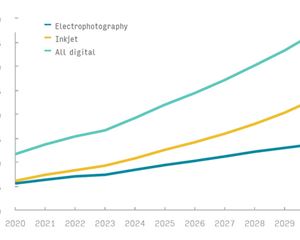Indian paper industry moving out of the woods
On 12 February 2018, the industry research firm Care Ratings released an industry research report on the Indian paper industry, titled ‘Indian Paper Industry – Moving out of the woods?’ The following is the highlights from the report.
23 May 2018 | By PrintWeek India
India’s share in global paper demand is gradually growing, as domestic demand is increasing at a steady pace while demand in the western nations is contracting. The domestic demand in India grew from 9.3 million tonnes in FY08 to 15.3 million tonnes in FY16 at a CAGR of 6.4%. In spite of the sustained growth witnessed by the industry, the per capita paper consumption in India stands at a little over 13 kg which is well below the global average of 57 kg and significantly below 200 kg in North America.
Overview
As per the estimates of the Indian Paper Mills Association (IPMA), this industry contributes approximately Rs 4,500 crore to the exchequer and provides employment to over 5 lakh people across approximately 750 paper mills. The broad characteristics of the industry are that it is capital-, energy- and water-intensive and highly fragmented (small units account for nearly 60% of the industry size).
The paper industry is classified under four segments — printing & writing (P&W), packaging paper and board, specialty papers and others, and newsprint.
Pulp (over 40% of raw material cost) is the primary raw material used for manufacturing of paper, and is obtained from wood, wastepaper, agriculture residues, etc. Wood accounts for 30-35% of raw material usage, while wastepaper and agri-residues account for 45-50% and 20-22%, respectively.
Projections
CARE Ratings expects that the overall paper demand growing at a CAGR of 6.6% is likely to touch 18.5 million tonnes in 2018-19. In the Printing and Writing segment demand is expected to grow at a CAGR of 4.2% and reach 5.3 million tonnes in FY19. The Demand for Packaging Paper and Board segment is expected to grow at a CAGR of 8.9% and reach 9.7 million tonnes in FY19. Meanwhile Newsprint demand is expected to reach 2.7 million tonnes in FY19.
The demand drivers include rising income levels; growing per capita expenditure; a likely pick-up from the education sector; requirement of better quality packaging of FMCG products marketed through organized retail, and increasing preference for ready-to-eat foods.
On the other hand, challenges include access to quality and cost competitive raw material whose prices have started increasing recently; competition from imports and technology obsolescence.
India’s share
India’s share in global paper demand, though small is growing as demand in the western nations contracts, while domestic demand in India grows at a steady pace.
Globally over 400 million tonnes of paper and paper products are consumed. The world's three largest paper producing countries are China, the US, and Japan (these three countries account for approximately half of the world's total paper production), while India accounts for a small but growing share of the global market. The global paper and pulp mills industry has contracted slightly over the past five years, primarily due to the shift to digital media and paperless communication across most developed economies. However, demand in emerging markets has partially offset the decline by driving increased demand for paper used in packaging materials.
The Indian Paper & Paperboard industry is one of the oldest organised manufacturing industries in India and the first paper mill was started in 1812 in Serampore, West Bengal. The industry accounts for approximately 4% of the world’s production of paper. IPMA (Indian Paper Mills Association) estimates the industry turnover at approximately Rs 50,000 crore which year contribution of Rs 4,500 crore to the exchequer while providing employment to over 5 lakh people across approximately 750 paper mills.
Domestic demand
The domestic demand in India grew from 9.3 million tonnes in FY08 to 15.3 million tonnes in FY16 at a CAGR of 6.4%. In spite of the sustained growth witnessed by the industry, the per capita paper consumption in India stands at a little over 13 kg, is way behind the global average of 57 kg and 200 kg in North America.
Growth drivers
For the Indian paper industry, strong economic growth has been accompanied by equally robust demand for paper. The demand drivers and growth triggers have come from a combination of factors such as rising income levels, growing per capita expenditure, rapid urbanisation and a larger proportion of earning population which is expected to lead consumption and there is enormous potential for the paper industry in the country. CARE Ratings expects that the overall paper demand growing at a CAGR of 6.6% is likely to touch 18.5 million tonnes in 2018-19. The individual segments are expected to grow as follows:
Printing and Writing segment demand is expected to grow at a CAGR of 4.2% and reach 5.3 million tonnes in FY19. The demand is expected to grow on account of an anticipated pick-up from the education sector with improving literacy rates and growing enrolment as well as increasing number of schools and colleges.
Packaging paper & board segment caters to industries such as FMCG, food & beverage, pharmaceutical, textiles, etc. Demand for Packaging Paper & Board segment is expected to grow at a CAGR of 8.9% and reach 9.7 million tonnes in FY19 due to factors such as increased urbanization, requirement of better quality packaging of FMCG products marketed through organized retail, and increasing preference for ready-to-eat foods.
Improving literacy rates, rising circulation and an increasing number of newspapers and magazines is expected to support growth in newsprint demand which is expected to reach 2.7 million tonnes in FY19.
Additionally, the Chinese Government has banned the import of several varieties of waste paper, which is the primary raw material for finished paper. Consequently, the production of finished paper is expected to be hampered in China. This in turn is expected to lead to some relief in raw material prices and improve realisations.
Rising income levels
In the last decade, Indian economy has progressed rapidly. Correspondingly, India’s per capita GDP has increased from Rs 71,607 in FY12 to Rs. 117,406 in FY17 at a CAGR of 10.4% fuelling a consumption boom in the country. Correspondingly, the per capita personal disposable income surged from Rs 73,476 in FY12 to Rs 119,296 in FY17 at a CAGR of 10.2%. Also, the per capita private final consumption expenditure too rose from Rs 40,250 in FY12 to Rs.68,049 in FY17 at a CAGR of 11.1%. The growth in country’s per capita GDP in turn has increased the disposable income of the populace ultimately driving the country’s consumption.
Population growth
The growing Indian population has also led to increase in the ‘earning population’ (age group 15-60) of the country. The proportion of Indian populace in the age group of 15-64 years increased from 55.4% in 1991 to 66.2% in 2016 (Source: CIA – The World Factbook). Considering the large size of the Indian population, the lower median age implies a higher number of working people thereby clearly outlining the immense earning as well as spending potential of the Indian populace. Taking into account the age group below 25 years being one of the highest spending age group, the current age dynamics are expected to boost the retail sales in India. The median age of India is 26.7 years, one of the lowest globally in comparison to 37.2 years in the US, 45.8 years in Japan and 36.3 years in China.
Increasing urbanisation
A majority of India still lives in ‘villages’. This statement no doubt holds true but the figures suggest that there has been a paradigm shift of the Indian populace in terms of rural–urban divide. The aspirations of higher income, higher standard of living etc. has drawn more and more people from villages to settle in towns and cities. This transition from rural to urban areas has led to an increase in the demand for goods (owing to higher income and ever-expanding needs) and has also shifted the consumption pattern.
Increase in literacy
Increase in the number of colleges and institution, rising enrolment numbers, rising literacy (continued government spending on education through the Sarva Shiksha Abhiyan) is expected to lead to an increased expenditure on textbooks, notebooks and other assorted paper products thereby driving demand. Additionally, with higher literacy levels, circulation of other print media, such as newspapers is also positively impacted.
Rising circulation of newspapers and magazines
As per the Audit Bureau of Circulation (ABC), the circulation of print media reached 62 million copies a day in 2016, implying a 10 year CAGR of nearly 5%. Indian language newspapers primarily contributed to this growth with Hindi, Telugu and Kannada language publications growing at a CAGR of 8.76%, 8.28% and 6.40% respectively. On the other hand, English publications grew at a CAGR of 2.87% in the same period. Further as per ABC, the circulation of Indian dailies grew at 12% between 2013 and 2015, while dailies in countries such as Australia, France, Germany, the US, and Japan witnessed a 3% - 6% decline.
Growth in packaging paper and board segment
After witnessing a growing rate of capacity addition in the early part of the decade, the planned domestic capacity (greenfield and brownfield) additions for paper and newsprint has slowed down, primarily due to a shortage of its key raw material i.e. pulp wood and rising prices of local waste paper. This has been partially mitigated by the agroforestry initiatives. However, the industry has been requesting for a policy to allow access to degraded forest land for paper mills to raise pulp wood plantations to enable sustainable source of raw materials.
On the other hand, driven by the increasing demand primarily from the e-commerce industry, packaging paper and board segment is expected to witness significant capacity addition across the country.
Challenges
Access to quality and cost competitive raw material
India is a wood fibre deficient country as the Government of India does not permit industrial plantations in the country and inadequate raw material availability domestically is a major constraint for the paper industry. Additionally, the recovery rate of wastepaper in India is quite low (~30%) due to lack of an effective collection mechanism. With issues like availability of quality raw material at competitive prices, the players depend on the imports of pulp, wastepaper and even pulpwood to meet their raw material needs and often have to pay premium for availing them thereby impacting profitability and capacity addition. To alleviate this significant challenge, the Government of India could frame a policy to allow access to degraded forest land for paper mills to raise pulp wood plantations for increasing pulp availability and reduce import dependence; further the collection mechanism needs to be strengthened to increase usage of wastepaper.
Competition from imports
Imports accounts for over 20% of the paper consumption in India. The domestic paper manufacturers are less competitive against imports, given superior quality and lower prices of imported paper. As per IPMA, paper from ASEAN countries that is produced from raw wood is available at about USD 40 per tonne, as against USD 110 per tonne in India. Rising imports at predatory prices from surplus countries like China, has been a major concern for local players in India. On account of cheaper imports domestic industry has faced challenges in pricing its products. An anti-dumping probe into cheap import of ‘uncoated paper’ from Indonesia, Thailand and Singapore has been initiated by the Government as the Directorate General of Anti-Dumping And Allied Duties (DGAD) has found ‘sufficient prima facie evidence’ of dumping of uncoated paper following complaints from some domestic companies.
Technology
As the Indian paper industry is largely fragmented with lower capacity with an individual paper mill, it is also prone to using outdated technology. Resultantly, it is estimated that both the raw material as well as the power consumption is higher as compared to a modern paper mill. Adoption of new technology by domestic paper producers would lead to emergence of more competitiveness in critical areas including quantifiable increase in productivity, quality improvement with reduced cost, improvement in energy efficiency and better compliance with environmental protection legislation and safeguards for eco-sustainability of the products.
Raw material scenario
Pulp is the primary raw material used for manufacturing of paper, and is obtained through processing of fibres separated from wood, wastepaper, agriculture residues etc. Indian paper mills are categorized based on raw materials used by them in the manufacture of paper - wood/forest based mills, agro-based mills and wastepaper based mills. Wood accounts for 30-35% of production, while wastepaper and agri-residues account for 45-50% and 20-22%, respectively. India has a total land area of 3.3 million sq km with forests covering only 0.7 million sq km. About 78% of the total land area is non-forest area. With diminishing forest resources and limitations on enlarging man-made forests, there is scarcity of raw material for paper mills. To counter the issue of wood deficit, Indian paper companies gave thrust to initiatives like agro forestry which have now started yielding results.
Due to the limited availability of wood, agro-based raw materials and waste paper are generally used as substitutes for manufacturing paper. However, a majority of pulp and paper mills integrate their operations to various options of raw materials like wood, bamboo, agro-residues, wastepaper and market pulp. In the backdrop of issues pertaining to raw material availability and quality being faced in India; the players depend on the imports for meeting their raw material needs, and often have to pay premium for availing them.
The pulpwood prices fell from the high in 2012 till 2014, however, the prices have been on an uptrend. In 2017Q3, the prices increased by 2% on a y-o-y basis, as compared to less than 1% in the previous quarter. Several factors such as challenging harvesting conditions due to the mild winter, and strong demand in China have influenced the prices.












 See All
See All